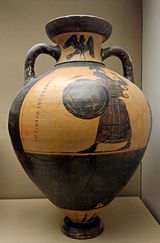
Panathenaic Amphorae
Encyclopedia

Panathenaic Games
The Panathenaic Games were held every four years in Athens in Ancient Greece since 566 BC. They continued into the third century AD. These Games incorporated religious festival, ceremony , athletic competitions, and cultural events hosted within a stadium.-Religious festival:The games were part of...
. This olive oil came from the sacred grove
Sacred grove
A sacred grove is a grove of trees of special religious importance to a particular culture. Sacred groves were most prominent in the Ancient Near East and prehistoric Europe, but feature in various cultures throughout the world...
of Athena at Akademia
Akademos
Akademos was an Attic hero in Greek mythology. The tale traditionally told of him is that when Castor and Polydeuces invaded Attica to liberate their sister Helen, he betrayed to them that she was kept concealed at Aphidnae...
; the amphorae which held it had the distinctive form of tight handles, narrow neck and feet and was decorated in a standard form using the black figure technique, and continued to be so long after the black figure style had fallen out of fashion. Some Panathenaic amphorae depicted Athena Promachos
Athena Promachos
The Athena Promachos was a colossal bronze statue of Athena sculpted by Pheidias, which stood between the Propylaea and the Parthenon on the Acropolis of Athens. Athena was the goddess of wisdom and warriors and the protectress of Athens...
, goddess of war, advancing between columns brandishing a spear and wearing the aegis, and next to her the inscription "(one) of the prizes from Athens". On the back of the vase was a representation of the event for which it was an award. Sometimes roosters are depicted perched on top of the columns: the significance of these is an open question. Later amphorae also had that year's archon
Archon
Archon is a Greek word that means "ruler" or "lord", frequently used as the title of a specific public office. It is the masculine present participle of the verb stem ἀρχ-, meaning "to rule", derived from the same root as monarch, hierarchy, and anarchy.- Ancient Greece :In ancient Greece the...
's name written on it making finds of the vases archaeologically important.

Exekias
Exekias was an ancient Greek vase-painter and potter, who worked between approximately 550 BC - 525 BC at Athens. Most of his vases, however, were exported to other regions of the Mediterranean, such as Etruria, while some of his other works remained in Athens. Exekias worked mainly with a...
(Karlsruhe 65.45). By the early 4th century we witness the inclusion of the archon's name, the earliest almost intact one being Asteios 373/2 BCE. (Oxford, 1911.257). However there is a fragment that bears the name Hippodamas of 375/4 BCE which may also be a panathenaic, and Beazley suggests there may be a preceding one; Pythokles of 392/1. As the century progresses the profile of the vases becomes elongated and the decoration more mannered. The last dated vase is from 312/11, though production continues into the 3rd and 2nd centuries the archons are no longer named, instead we have recorded the treasurers and stewards of the games. Some vases were used as grave goods by the victor's families, some dedicated to sanctuaries and others still sold on hence their wide distribution in the Greek world.
The survival rate of Greek pottery as a whole may be calculated from the remnant of panathenaic amphorae come down to us. After approximately 350 BCE at least 1450 vases were awarded every four years in the greater Panathenaia. Assuming the number of events was consistent throughout the history of the games and that all prizes were in the form of decorated amphora we can divide the number of unique vases known to us by the total production run, giving us the figure of 0.25% of all Greek vases are still extant.
Sources
- John Boardman: Athenian Black Figure Vases, London 1974.
- Jenifer Neils:Goddess and Polis: The Panathenaic Festival in Ancient Athens, Hood Museum of Art, 1992.
- Martin Bentz: Panathenäische Preisamphoren: eine athenische Vasengattung und ihre Funktion vom 6. - 4. Jahrhundert v. Chr. Basel, Vereinigung der Freunde Antiker Kunst 1998. (Antike Kunst: Beihefte; 18) ISBN 3-909064-18-3
- Martin Bentz; Norbert Eschbach (Hrsg.): Panathenaïka : Symposion zu den Panathenäischen Preisamphoren, Rauischholzhausen 25.11. - 29.11.1998. Mainz, Zabern 2001. ISBN 3-8053-2708-0
- S. A. Callisen: The Iconography of the Cock on the Column, The Art Bulletin, Vol. 21, No. 2 (Jun., 1939), pp. 160-178

